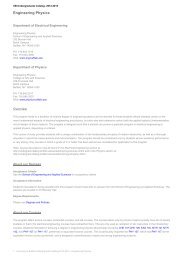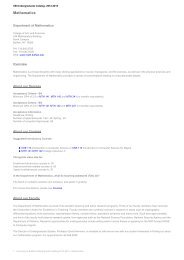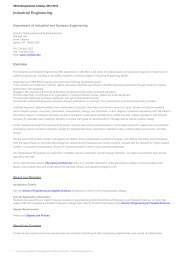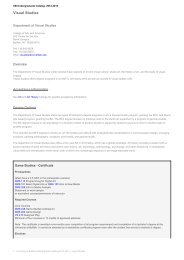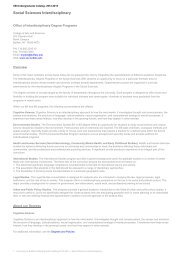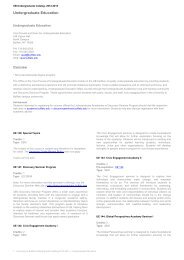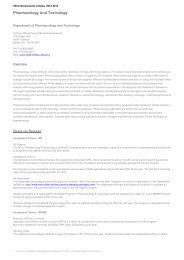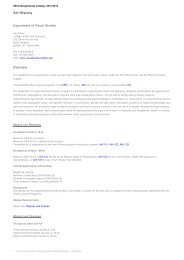Examples of Academic DishonestyAcademic dishonesty includes, but is not limited to, the following:• Previously submitted work. Submitting academically required materialthat has been previously submitted—in whole or in substantial part—inanother course, without prior and expressed consent of the instructor.• Plagiarism. Copying or receiving material from any source and submittingthat material as one’s own, without acknowledging and citing theparticular debts to the source (quotations, paraphrases, basic ideas), orin any other manner representing the work of another as one’s own.• Cheating. Soliciting and/or receiving information from, or providinginformation to, another student or any other unauthorized source(including electronic sources such as cellular phones and PDAs), withthe intent to deceive while completing an examination or individualassignment.• Falsification of academic materials. Fabricating laboratory materials,notes, reports, or any forms of computer data; forging an instructor’sname or initials; resubmitting an examination or assignment for reevaluationwhich has been altered without the instructor’s authorization; orsubmitting a report, paper, materials, computer data, or examination (orany considerable part thereof) prepared by any person other than thestudent responsible for the assignment.• Misrepresentation of documents. Forgery, alteration, or misuse ofany University or Official document, record, or instrument ofidentification.• Confidential academic materials. Procurement, distribution or acceptanceof examinations or laboratory results without prior and expressedconsent of the instructor.• Selling academic assignments. No person shall sell or offer for sale toany person enrolled at the University at Buffalo any academic assignment,or any inappropriate assistance in the preparation, research, orwriting of any assignment, which the seller knows, or has reason tobelieve, is intended for submission in fulfillment of any course or academicprogram requirement.• Purchasing academic assignments. No person shall purchase an academicassignment intended for submission in fulfillment of any course oracademic program requirement.Consultative ResolutionStep 1If an instructor has reason to believe that a student may have committedan act of academic dishonesty, the instructor shall notify the studentsuspected of academic dishonesty by e-mail to the student’s UB IT addresswith receipt requested, by certified mail return receipt requested, or bywritten notice delivered in person with a copy countersigned by the studentand retained by the instructor within 10 academic days 1 of discovery of thealleged incident.Once the alleged incident has occurred, the student may not resign fromthe course without permission of the instructor.The instructor shall meet and consult with the student within 10 academicdays 1 of the date of notification. If the student fails to attend theconsultative meeting, the instructor has the authority to reach a decisionand to impose a sanction (if appropriate) without the student consultation.At consultation, the instructor shall inform the student of the allegationsrelating to the specific infringement, and the student shall be given acopy of the Academic Integrity Policy and Procedures.At the request of either or both parties, the consultation may berecorded. A departmental note-taker (a staff or faculty member, but not ateaching assistant) may record consultation proceedings. The student mustagree to the presence of the note-taker, and the student may also have anote-taker in attendance.Step 2If, after consultation with the student, the instructor believes the studentdid not commit an act of academic dishonesty, no sanctions may beimposed. The instructor will orally inform the student of that finding and,if the student so requests, will provide the student with a written statementconfirming that finding. Procedures end.If, after consultation with the student, the instructor believes the studentdid commit an act of academic dishonesty, the instructor has the authorityto impose one or more of the following sanctions:. Warning. Written notice to the student that he/she has violated auniversity academic integrity standard and that the repetition of thewrongful conduct may be cause for more severe sanctions.2. Revision of Work. Requiring the student to replace or revise the workin which dishonesty occurred. (The instructor may choose to assigna grade of “I” [Incomplete] pending replacement or revision of thework.)3. Reduction in Grade. With respect to the particular assignment/examor final grade in the course.4. Failure in the Course. To be indicated on the transcript by a grade of“F” without comment.5. Such other reasonable and appropriate sanction(s) as may be determinedby the instructor (or committee at later levels of review) with theexception of those subsequently described under #6.6. Recommendation of any of the following University sanctions(these require approval at the department, college/school, and ViceProvost levels).a. Failure in the Course with Citation of Academic Dishonesty:To be indicated by an “F” on the transcript with the notationthat the grade of “F” was assigned for reason of academicdishonesty. Only the Vice Provost of <strong>Undergraduate</strong> Educationor his or her designee may impose this sanction.b. Suspension from the University: For a definite term uponstated conditions. Only the University President or his/her designeemay suspend a student from the University.c. Expulsion from the University: With comment on the transcript.Only the University President or his/her designee mayexpel a student from the University.Step 3The instructor shall provide the student with a copy of the decision,sanction(s) imposed, and the student’s right to appeal that decision. Theinstructor’s decision letter shall be sent to the student (via certified, returnreceipt mail), the department chair, and the Vice Provost of <strong>Undergraduate</strong>Education within 10 academic days 1 of the date of the consultation meeting.This statement of decision shall be included in the student’s confidentialfile maintained in the Office of the Vice Provost of <strong>Undergraduate</strong>Education. The student shall have access to this file.University Sanctions. If the sanctions imposed at the instructor levelinclude recommendation of University sanctions (as listed in Step 2.6),departmental level procedures are required, and shall be initiated within10 academic days 1 of the department chair’s receipt of the statement ofdecision.Right to Appeal. The student may appeal the instructor’s findings. Thestudent’s request for an appeal, including specification of the grounds forappeal, must be submitted in writing to the instructor and to the departmentchair no later than 10 academic days 1 after the instructor has notifiedthe student of his or her decision.Departmental Level ProceduresStep 1The instructor and student have no more than 10 academic days 1 followingthe filing of the request for the initiation of departmental proceedings todeliver evidentiary materials to the department chair. The instructor andstudent shall each provide the department chair with a written statement ofevidence supporting his or her position, any relevant documentation, andthe names of potential witnesses.If the department chair is the faculty member who has brought the academicdishonesty charge against the student, or if a department is unableto assemble a committee because of a limited number of faculty or students,direct consideration at the college or school level may be requested.University at Buffalo • <strong>Undergraduate</strong> <strong>Catalog</strong> 2007-08 15ACADEMIC POLICIES AND PROCEDURES
ACADEMIC POLICIES AND PROCEDURESPending resolution, the instructor shall temporarily assign a grade of “I”(Incomplete). This “I” grade can only be adjusted by resolution of the case.Step 2Upon review of relevant materials (including all evidence and statementscommunicated during consultation), if the department chair does notdeem it necessary to consider further the circumstances of the case, thedepartment chair will notify the student (via certified, return receipt mail),the instructor, the cognizant academic dean, and the Vice Provost of<strong>Undergraduate</strong> Education of his or her decision within 20 academic days 1of receipt of the student’s appeal or instructor’s recommendation. If thesanctions imposed at this stage include recommendation of university sanctions(as listed in Consultative Resolution Step 2.6), decanal level proceduresare required (see “Decanal Level Procedures”).Alternatively, if the department chair deems it necessary to considerfurther the circumstances of the case, he or she shall convene the DepartmentalAdjudication Committee within 20 academic days 1 of the datethe department office received the request for initiation of departmentalproceedings.The department office shall convey all evidentiary materials to the DepartmentalAdjudication Committee, the student, and the instructor at thetime the notice of the hearing is delivered. The student and the instructorshall be given at least 72 hours notice of the hearing.At hearing(s), the Departmental Adjudication Committee shall providesufficient opportunity for both principals to present their positions andshall allow each principal the right to question the presentation(s), writtenor verbal, of those who contribute information to the committee.The hearing(s) shall be conducted in a fair and expeditious manner,but shall not be subject to the rules governing a legal proceeding. Eachprincipal shall have the right to be present (under unusual circumstances,if either party is considered to pose a physical threat to the other or to thecommittee, the chair of the committee may request that either the studentor instructor participate by phone) and to have one advisor present at allhearings.The technical and formal rules of evidence applicable in a court of laware not controlling, and the committee may hear all relevant and reliableevidence that will contribute to an informed result. The Departmental AdjudicationCommittee shall only consider evidence presented at hearing(s).Discussion of a student’s formerly alleged or documented academicmisconduct shall not be admissible as evidence to determine whether thestudent is responsible for breaching the university’s academic integrity codein the current case, although such history may be introduced and consideredduring the sanctioning phase. Hearings shall be confidential.The Departmental Adjudication Committee shall provide the departmentchair with a written statement of recommendations and reasons forrecommendations within 10 academic days 1 after the final meeting of thecommittee. Recommendations may include:. Findings Overturned. Finding that no academic dishonesty took placeand that no sanctions should be imposed.2. Findings Sustained. Finding that academic dishonesty occurred, andthe committee is in agreement with the sanction(s) previously imposedor recommended.3. Finding of Different Sanction. Finding that academic dishonestyoccurred, but that the sanction(s) previously imposed or recommendedare inappropriate and that greater or lesser sanction(s) should beimposed.Step 3The department chair considers the committee’s findings and recommendationsand renders a final decision. The department chair’s decision andthe student’s right to appeal that decision shall be submitted in writing fromthe department chair to the student (via certified, return receipt mail), theinstructor, the cognizant academic dean, and the Vice Provost of <strong>Undergraduate</strong>Education within 10 academic days 1 from receiving the DepartmentalAdjudication Committee’s statement of recommendations.The department chair shall forward the record of the matter consistingof all written communications, all written evidence, an audiotape or otherrecord of the hearing, and its statement of recommendations to the Vice16 <strong>Undergraduate</strong> <strong>Catalog</strong> 2007-08 • University at BuffaloProvost of <strong>Undergraduate</strong> Education, where a confidential file will bemaintained. The student shall have access to this file.University Sanctions. If the sanction(s) imposed at the departmental levelinclude recommendation of university sanctions (as listed in ConsultativeResolution Step 2.6), decanal level procedures are required, and shall beinitiated within 10 academic days 1 of the dean’s receipt of the statement ofdecision.Right to Appeal. The student or the instructor may appeal the departmentchair’s findings. The request for an appeal, including specification of thegrounds for appeal, must be submitted in writing to the department chairand to the cognizant academic dean no later than 10 academic days 1 afterthe department chair has notified the student of his or her decision.Decanal Level ProceduresStep 1The instructor and student have no more than 10 academic days 1 followingthe filing of the request for the initiation of decanal level proceedings todeliver evidentiary materials to the cognizant academic dean. The instructorand student shall each provide the academic dean with a written statementof evidence supporting his or her position, any relevant documentation,and the names of potential witnesses.Pending resolution, the temporarily assigned grade of “I” (Incomplete)will continue in place. This “I” grade can only be adjusted by final resolutionof the pending case.Step 2Upon review of relevant materials (including all evidence and statementscommunicated during consultation), if the academic dean does notdeem it necessary to consider further the circumstances of the case, theacademic dean will notify the student (via certified, return receipt mail), theinstructor, the department chair, and the Vice Provost of <strong>Undergraduate</strong>Education of his or her decision within 20 academic days 1 of receipt of thestudent’s appeal or instructor’s recommendation. If the sanctions imposedat this stage include recommendation of university sanctions (as listed inConsultative Resolution Step 2.6), a hearing at the decanal level is required,and procedures below shall be initiated within 20 academic days 1 of theacademic dean’s receipt of the department chair’s statement of decision.Alternatively, if the academic dean deems it necessary to considerfurther the circumstances of the case, he or she shall convene the DecanalAdjudication Committee within 20 academic days 1 of the date whichthe academic dean received the request for initiation of decanal levelproceedings.The academic dean’s office shall convey all evidentiary materials to theDecanal Adjudication Committee, the student, and the instructor at thetime the notice of the hearing is delivered. The student and the instructorshall be given at least 72 hours notice of the hearing.At hearing(s), the Decanal Adjudication Committee shall provide sufficientopportunity for both principals to present their positions and shallallow each principal the right to question the presentation(s), written orverbal, of those who contribute information to the committee.The hearing(s) shall be conducted in a fair and expeditious manner,but shall not be subject to the rules governing a legal proceeding. Eachprincipal shall have the right to be present (under unusual circumstances,if either party is considered to pose a physical threat to the other or to thecommittee, the chair of the committee may request that either the studentor instructor participate by phone) and to have one advisor present at allhearings.The technical and formal rules of evidence applicable in a court of laware not controlling, and the committee may hear all relevant and reliable evidencethat will contribute to an informed result. The Decanal AdjudicationCommittee shall only consider evidence presented at hearing(s). Discussionof a student’s formerly alleged or documented academic misconduct shallnot be admissible as evidence to determine whether the student is responsiblefor breaching the university’s academic integrity code in the currentcase, although such history may be introduced and considered during thesanctioning phase. Hearings shall be confidential.



